Betelgeuse is dimming again. . . somewhat. After its historic fade last winter to magnitude +1.6, Orion's red supergiant Betelgeuse fully recovered, to +0.4, before it disappeared into the sunset for the season. But now as it emerges low in the east before dawn, it seems to have faded back down to about +0.9. However, accurate measurements are hard to make when a star is seen at low altitude through thick atmospheric extinction that has to be corrected for. Betelgeuse and its comparison stars are getting a little higher every morning. Stay tuned!
FRIDAY, AUGUST 28
■ Jupiter this evening shines just a couple degrees above the gibbous Moon for North America; see the twilight view below. To their left, Saturn waits its turn.
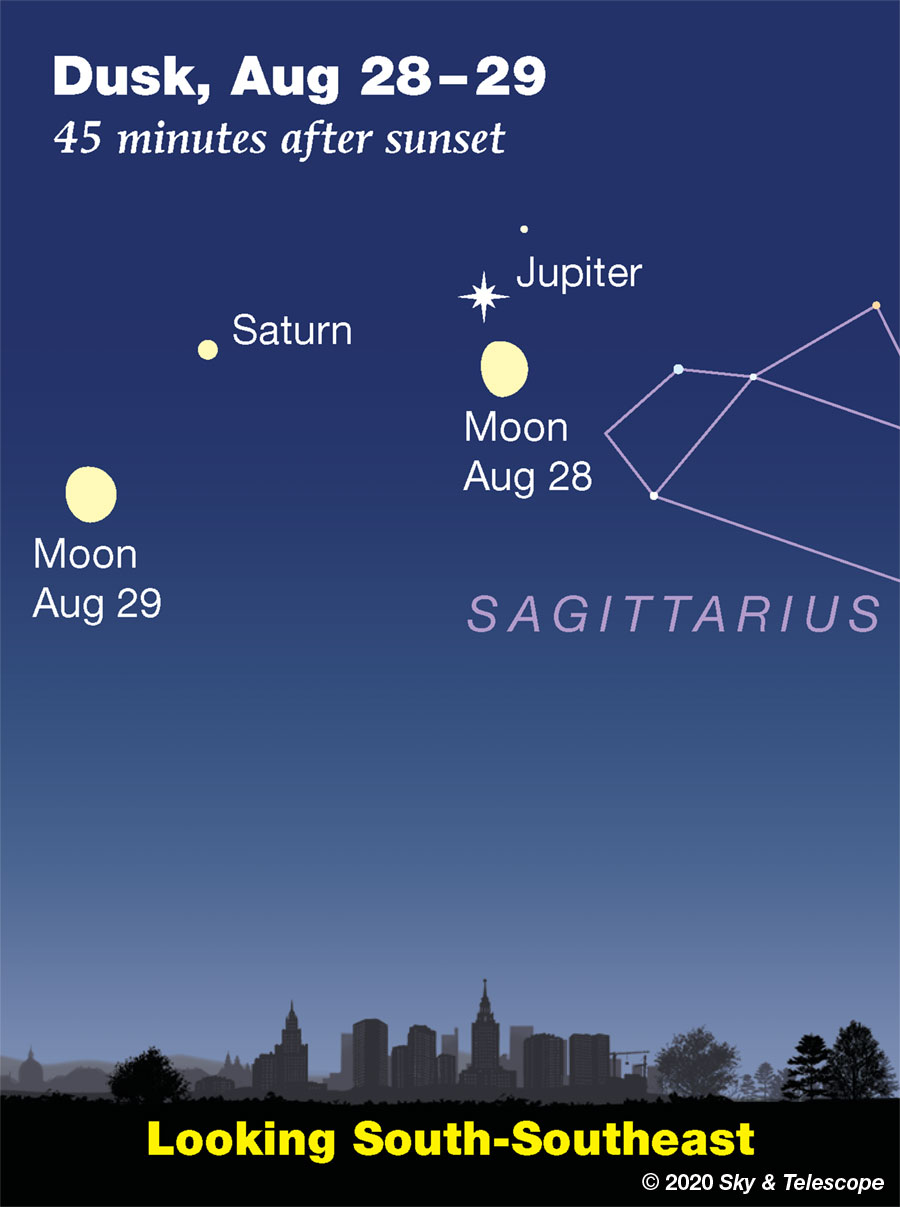
■ Ceres, the first asteroid discovered (in 1801) is just past opposition this week, at magnitude 7.7 in southern Aquarius. It's about 6° north-northeast of 1st-magnitude Fomalhaut, which is your easy starting point late these evenings for a careful star hop to identify Ceres using the finder chart in the August Sky & Telescope, page 50. Good binoculars may do. Ceres remains that bright all this week as it creeps along.
SATURDAY, AUGUST 29
■ Now the eastward-marching Moon shines closer to Saturn than to Jupiter, as shown above. The three are, of course, at very different distances: The Moon is 1.3 light-seconds from you, Jupiter is currently 37 light minutes distant, and Saturn is 77 light-minutes away.
■ Jupiter's Great Red Spot should transit the planet's central meridian (the line down its center from pole to pole) around 9:28 p.m. Eastern Daylight Time. It should be visible for about an hour before and after in a good 4-inch telescope if the atmospheric seeing is sharp and steady. A light blue or green filter helps. The Red Spot transits about every 9 hours 56 minutes.
SUNDAY, AUGUST 30
■ Whenever bright Vega crosses nearest your zenith, as it does right after dark now, you know that the Sagittarius Teapot is at its highest due south.
Two hours later when Deneb crosses closest to the zenith, it's the turn of little Delphinus and boat-shaped Capricornus down below to stand at their highest due south.
MONDAY, AUGUST 31
■ Action at Jupiter: Io, Jupiter's fast-moving inner moon, should emerge out of eclipse from Jupiter's shadow around 9:53 p.m. EDT. Watch for it to glimmer into view a little east of the planet, between Jupiter itself and Europa farther out. First there will be one moon there, then, gradually, two.
About an hour later, Io and Europa will pass each other in conjunction at 10:56 p.m. EDT.
And a few minutes later, Jupiter's Great Red Spot should transit the planet's central meridian around 11:10 p.m. EDT.
TUESDAY, SEPTEMBER 1
■ Full Moon tonight (exact at 1:22 a.m. EDT). The Moon shines in dim Aquarius. During evening in North America, the Moon is almost on the line from the west side of the Great Square of Pegasus down to Fomalhaut.
WEDNESDAY, SEPTEMBER 2
■ The coming of September means that Scorpius, which was the proud starring constellation of the southern sky in July, is now tilting over and lying down in the southwest after dark, preparing to bed down and drift off for the season.
THURSDAY, SEPTEMBER 3
■ The wide W pattern of Cassiopeia is tilting up in the northeast these nights. Look below the W's last segment, the one on the lower left, by a little farther than the segment's length. Can you see an enhanced little spot of the Milky Way's glow here? Binoculars will show it to be the Perseus Double Cluster — even through a fair amount of light pollution.
■ Jupiter's Great Red Spot should transit around 8:40 p.m. EDT.
FRIDAY, SEPTEMBER 4
■ The waning gibbous Moon rises around the end of twilight this evening. Once it's up, watch for fiery Mars, now unusually bright at magnitude -2.0, to rise about a fist-width or a little more to the Moon's lower left. They climb high as evening grows late.
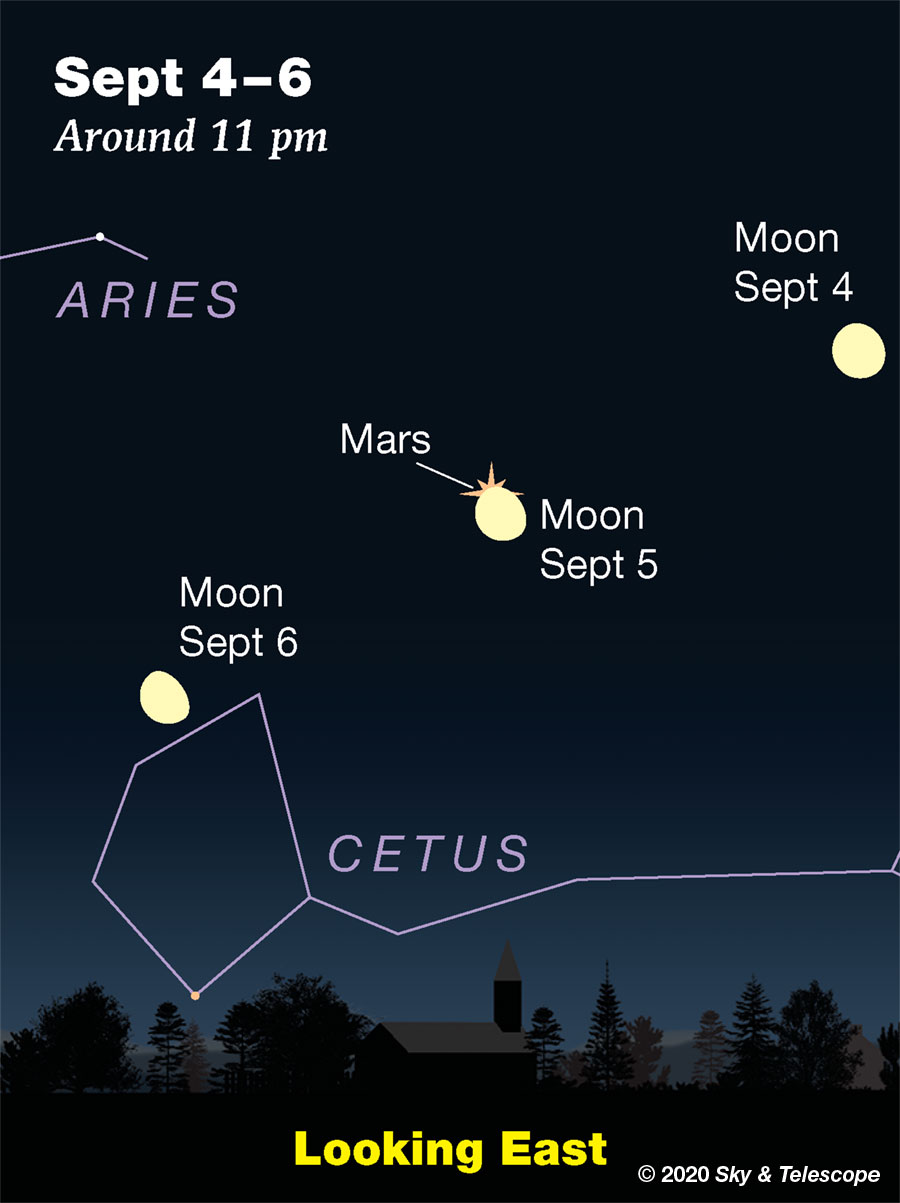
SATURDAY, SEPTEMBER 5
■ The Moon and Mars rise together in the east about a half hour after the very end of twilight. For skywatchers in North America, they'll be only about 1° apart or less. By dawn Sunday, they'll stand high in the southwest 2° or 3° apart.
■ Jupiter's Great Red Spot should transit Jupiter's central meridian around 10:18 p.m. EDT.
This Week's Planet Roundup
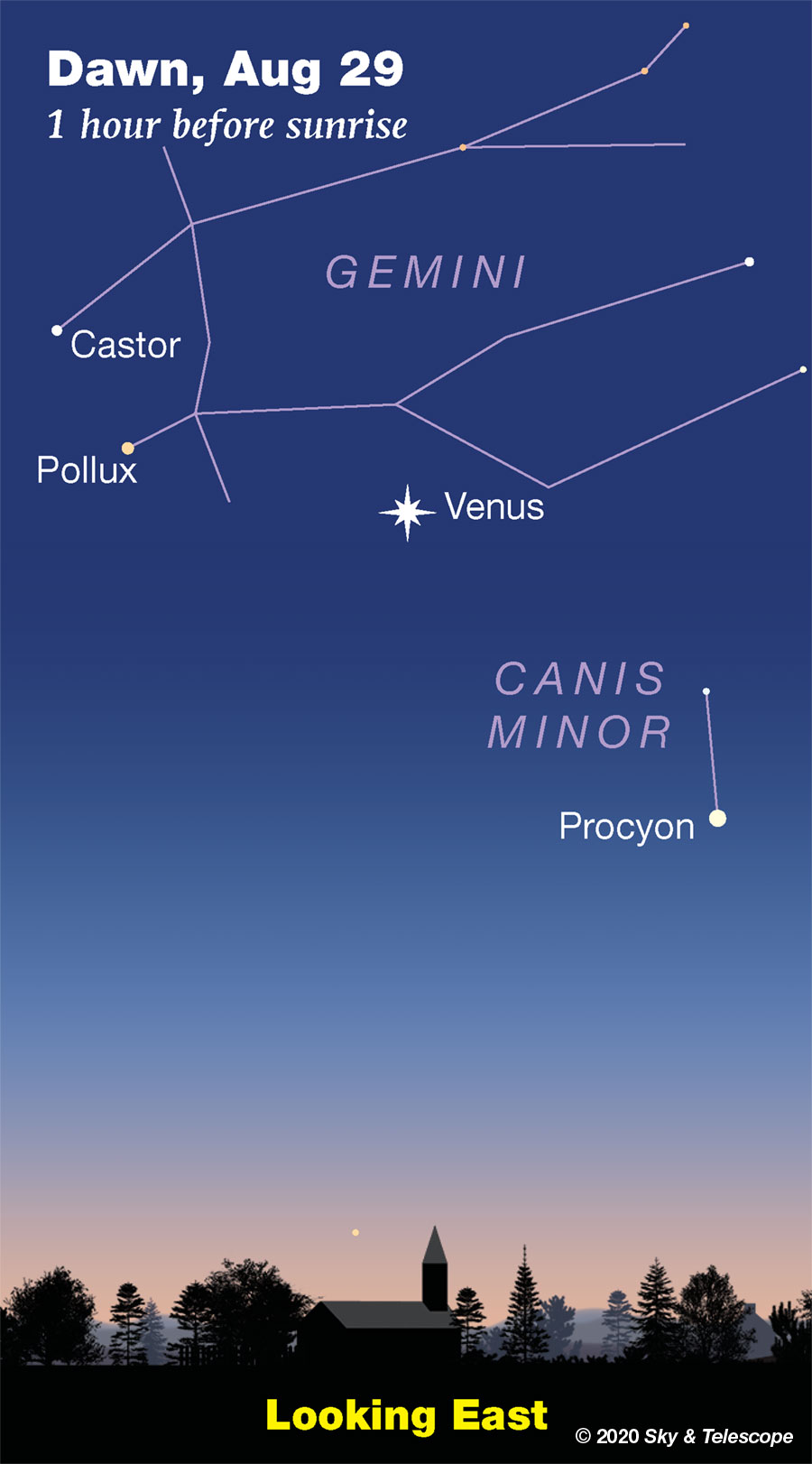
Mercury is hidden deep in the sunset.
Venus (magnitude –4.3, in Gemini) rises in deep darkness two hours before dawn begins, a weird UFO of a thing in the east-northeast. By the time dawn gets under way, Venus blazes brightly high in the east as shown above.
Venus stands just a little lower each morning, while the background stars move rapidly to the upper right as the days progress. Venus will cross the line from Pollux to Procyon on September 1st.
In a telescope Venus continues to shrink (it's now 20 arcseconds in diameter) while becoming slightly gibbous (59% sunlit).
Mars rises in the east only about a half hour after the end of twilight. It emerges orange and bright (magnitude –1.8), far below the Andromeda-Pegasus constellation complex.
Mars climbs higher through the night. It shines at its highest and telescopic best by around 4 a.m. daylight-saving time, lording over the world from high in the south. It's near the dim Knot of Pisces.
In a telescope this week Mars grows from 18½ to 19½ arcseconds in apparent diameter. That's already as big as it appears at its average opposition, but it's still got a ways to go. When Earth finally catches up to and passes Mars at opposition in early October, it will be 22.6 arcseconds wide and will shine at a Jupiter-bright magnitude –2.6.
Mars is still gibbous, 92% sunlit. Look for its white South Polar cap, possible clouds especially near the limb, and dusky surface markings. To get a map of the side facing Earth at the date and time you'll observe, use our Mars Profiler. The map there is square; remember to mentally wrap it onto the side of a globe. (Features near the map's edges become very foreshortened.)
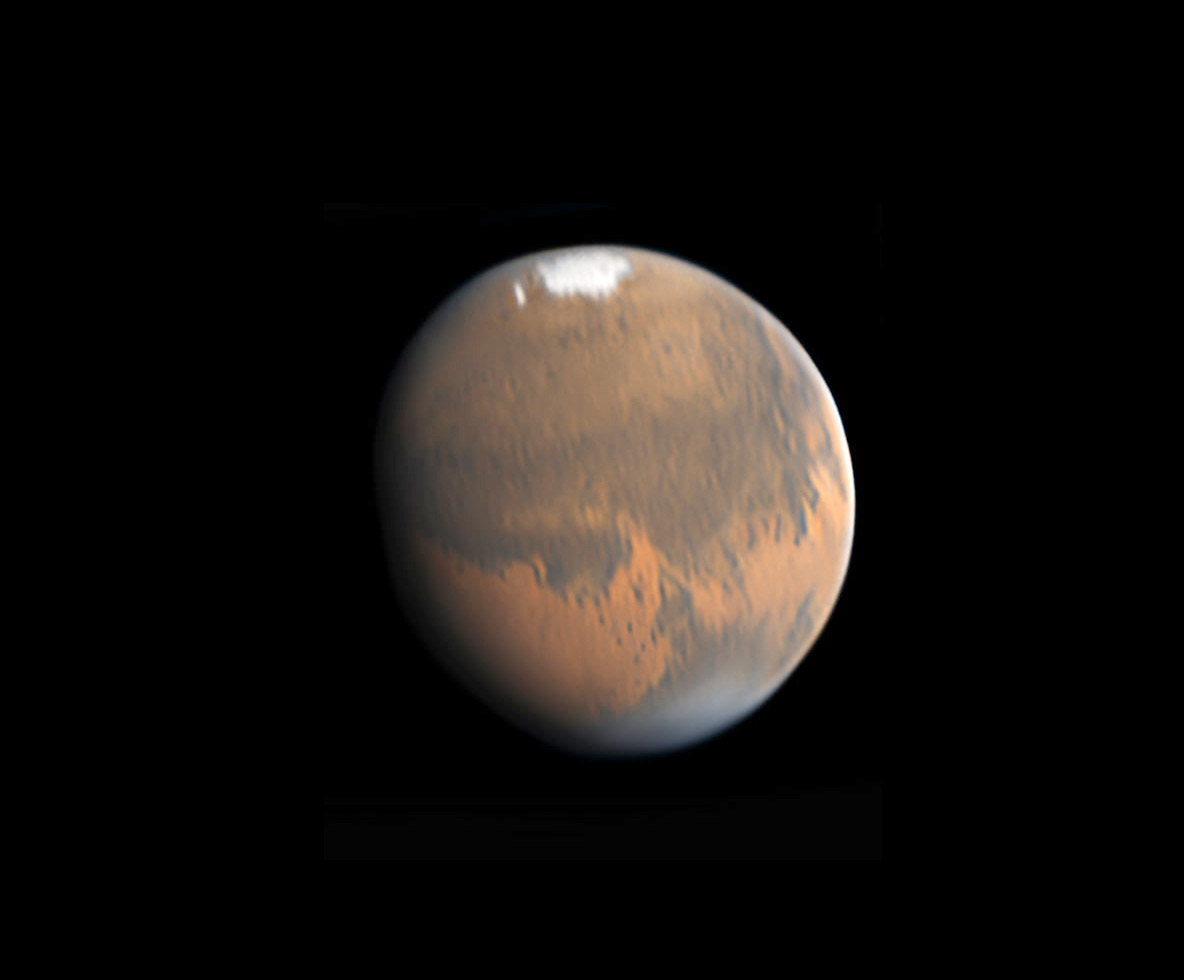
Jupiter and Saturn (magnitudes –2.6 and +0.3, respectively) shine in the south in early evening. Jupiter is the brightest; Saturn is 8° to its left.
They're perfectly horizontal right around the end of twilight, like some great pair of eyes. Lower right of Jupiter after dark is the handle of the Sagittarius Teapot.
Follow the telescopic interplay of Jupiter with its moons and their shadows, and find all the transit times of Jupiter's Great Red Spot, in the Celestial Calendar section of the current month's Sky & Telescope, page 50.
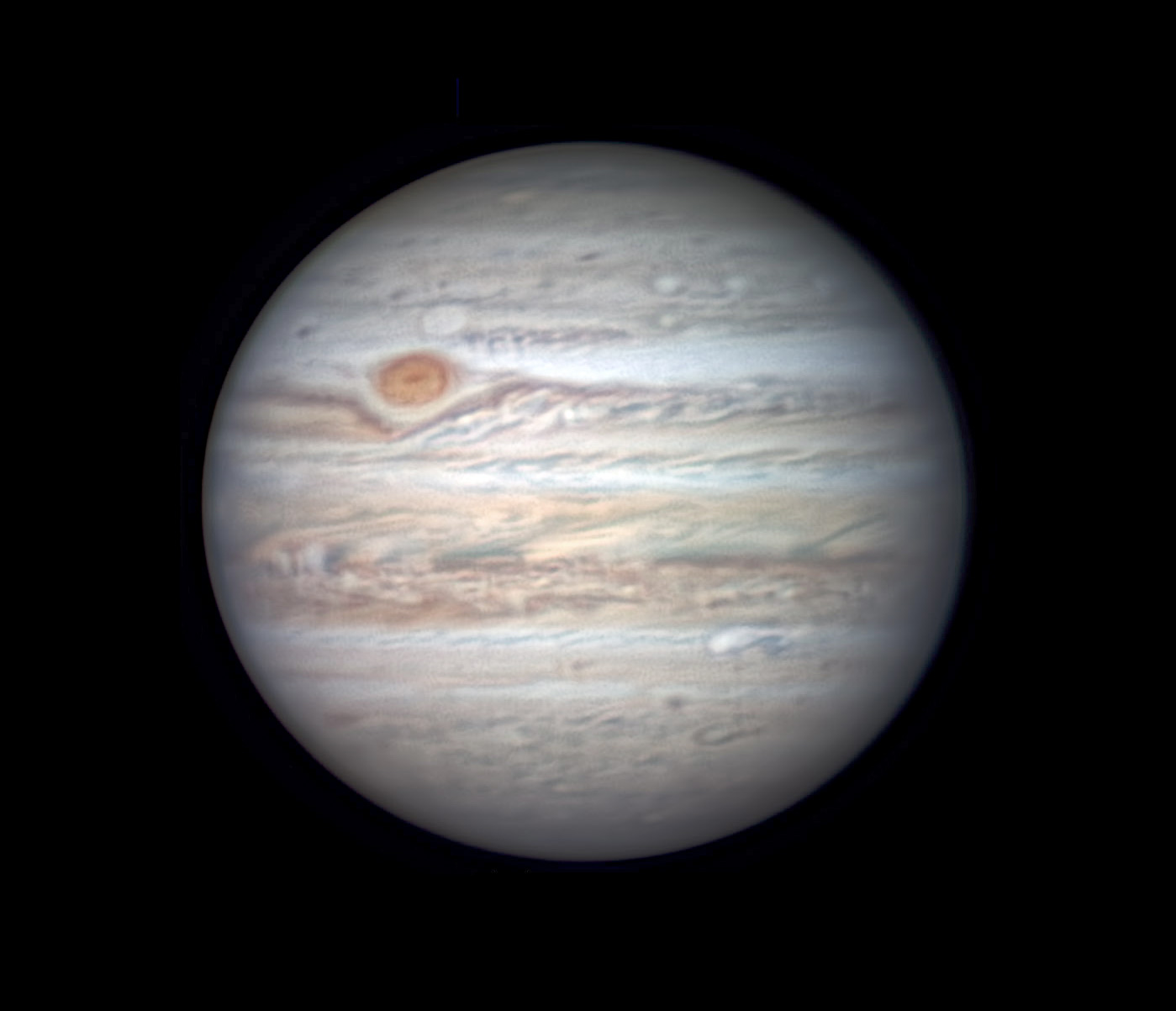
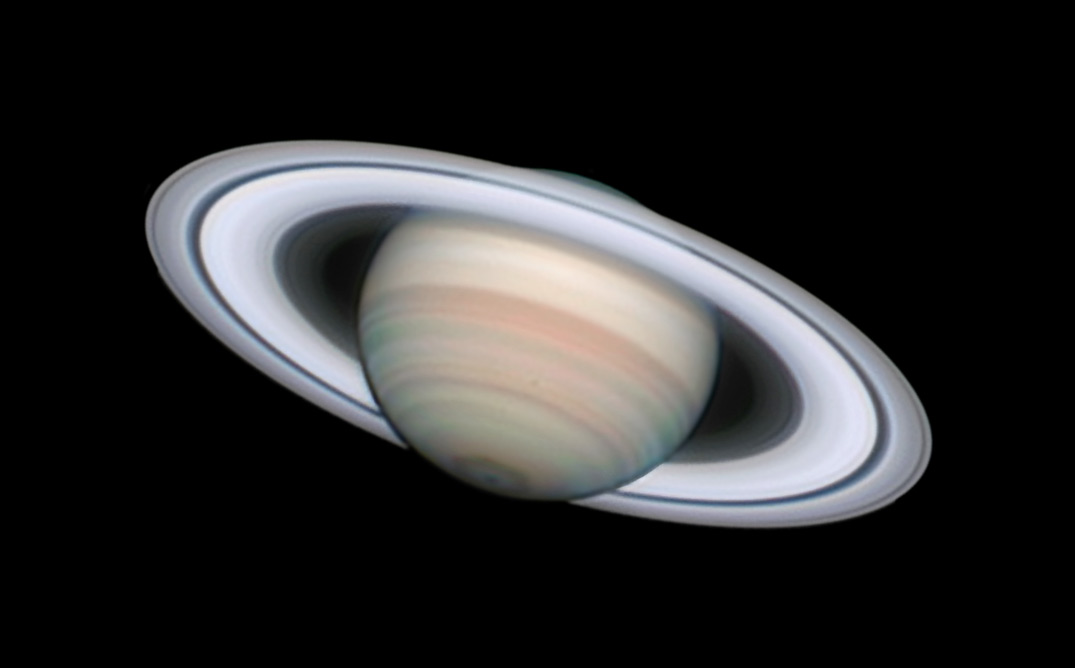
Uranus (magnitude 5.8, in Aries) is pretty well up in the east by midnight daylight-saving time, east of Mars.
Neptune (magnitude 7.8, in Aquarius) is higher in the southeast by that time. Finder charts for Uranus and Neptune.
All descriptions that relate to your horizon — including the words up, down, right, and left — are written for the world's mid-northern latitudes. Descriptions that also depend on longitude (mainly Moon positions) are for North America.
Eastern Daylight Time, EDT, is Universal Time (also known as UT, UTC, GMT, or Z time) minus 4 hours.
Want to become a better astronomer? Learn your way around the constellations. They're the key to locating everything fainter and deeper to hunt with binoculars or a telescope.
This is an outdoor nature hobby. For an easy-to-use constellation guide covering the whole evening sky, use the big monthly map in the center of each issue of Sky & Telescope, the essential magazine of astronomy.
Once you get a telescope, to put it to good use you'll need a detailed, large-scale sky atlas (set of charts). The basic standard is the Pocket Sky Atlas (in either the original or Jumbo Edition), which shows stars to magnitude 7.6.

Next up is the larger and deeper Sky Atlas 2000.0, plotting stars to magnitude 8.5; nearly three times as many. The next up, once you know your way around, are the even larger Interstellarum atlas (stars to magnitude 9.5) or Uranometria 2000.0 (stars to magnitude 9.75). And read how to use sky charts with a telescope.
You'll also want a good deep-sky guidebook, such as Sky Atlas 2000.0 Companion by Strong and Sinnott, or the bigger (and illustrated) Night Sky Observer's Guide by Kepple and Sanner.
Can a computerized telescope replace charts? Not for beginners, I don't think, and not on mounts and tripods that are less than top-quality mechanically, meaning heavy and expensive. And as Terence Dickinson and Alan Dyer say in their Backyard Astronomer's Guide, "A full appreciation of the universe cannot come without developing the skills to find things in the sky and understanding how the sky works. This knowledge comes only by spending time under the stars with star maps in hand."
![]() Audio sky tour. Out under the evening sky with your
Audio sky tour. Out under the evening sky with your
earbuds in place, listen to Kelly Beatty's monthly
podcast tour of the heavens above. It's free.
"The dangers of not thinking clearly are much greater now than ever before. It's not that there's something new in our way of thinking, it's that credulous and confused thinking can be much more lethal in ways it was never before."
— Carl Sagan, 1996
"Facts are stubborn things."
— John Adams, 1770
 4
4








Comments
Rod
August 30, 2020 at 8:32 am
mary beth, I did some Venus and Mars observing early this morning using my 90-mm refractor telescope. [Observed 0530-0600 EDT, 0930 UT - 1000 UT. Sunrise 0635 EDT/1035 UT. Views at 71x, 1-degree true FOV, enjoyed some excellent views of Venus and Mars early this morning. Venus a bit more than 58% illuminated and Mars is now a very nice planet disk shape with some surface features visible, even at 71x. Mars position framed by four stars in Pisces, visible in the telescope view, magnitudes 8th-9th, three formed a triangle shape. This is a good position fix in Pisces before Mars retrogrades on 09-Sep-2020. The four stars <= 18' angular separation from Mars. Enjoyable time viewing Venus and Mars this morning. Skies mostly clear with some cirrus. Mars near 19 arcsecond size and Venus 20 arcsecond size. Easy views at 71x with 1-degree true FOV.]
You must be logged in to post a comment.
mary beth
August 30, 2020 at 2:05 pm
Hi Rod! Sounds like you saw a miniature ‘late’ Summer Triangle’ Within Pisces! Interesting! Will Venus Be getting more or less illumination in September?
You must be logged in to post a comment.
Rod
August 31, 2020 at 5:38 pm
mary beth, Venus will be more illuminated on its surface but diminishing in brightness too. Venus arcsecond size is shrinking as the distance between Earth and Venus increases. You can see these changes by comparing the August Sky & Telescope Planetary Almanac with the September Sky & Telescope. I think Stellarium calculates this too---Rod
You must be logged in to post a comment.
Tony
August 30, 2020 at 7:17 pm
When I saw Betelgeuse on July 30 it looked barely brighter than Pollux (at my latitude on Vancouver Island, a line between the two is almost parallel with the horizon as they rise). Three weeks later, Betelgeuse looked more definitely brighter.
You must be logged in to post a comment.
You must be logged in to post a comment.